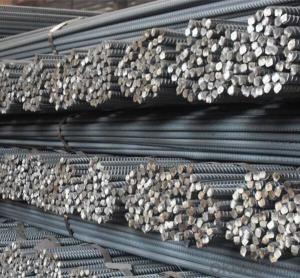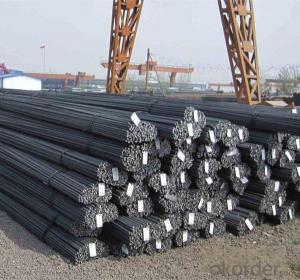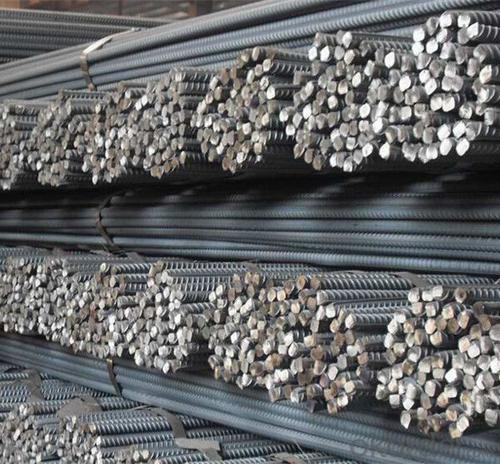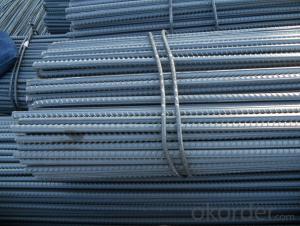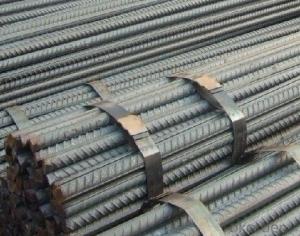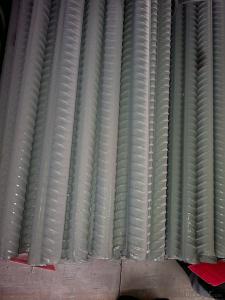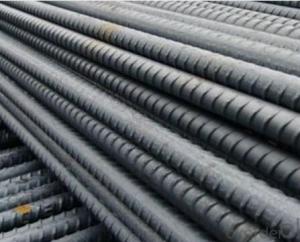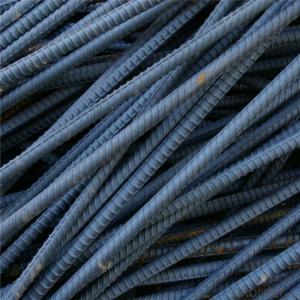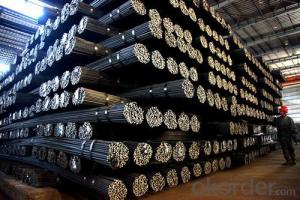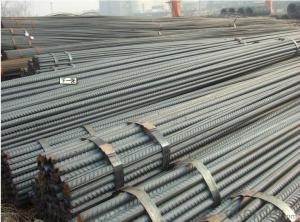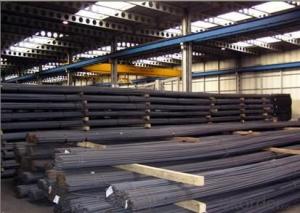Deformed Steel Bar Astm A615 Grade 40 Grade 60 Rebar Steel Prices
- Loading Port:
- Tianjin
- Payment Terms:
- TT OR LC
- Min Order Qty:
- 100 m.t.
- Supply Capability:
- 100000 m.t./month
OKorder Service Pledge
OKorder Financial Service
You Might Also Like
Specification
Deformed Steel Bar Astm A615 Grade 40 Grade 60 Rebar Steel Prices
Products Description:
Rebar is common known as steel reinforcing bar, usually applied to reinforced concrete and reinforced masonry structures. Formed from mild steel, it is given ribs for better frictional adhesion to the concrete. In other words rebar is an iron rod, a weldable plain reinforcing steel bar, that it can be also used for steel meshes.
1. Diameter: 5.5mm-10mm rounds reinforcing steel bar
10m- 40 rods reinforcing deformed steel bar
2. Length: 6m, 9m, 12m or customized
3. Standard: GB, ASTM, AISI, SAE, DIN, JIS, EN. OEM technology - send detailed technical parameters for accurate quotation.
4. Produce Process: smelt iron - EAF smelt billet - ESR smelt billet - hot rolled or forged to get the steel round bar and plate
5. Heat Treatment: annealing, normalizing, tempering, quenching
6. Surface Treatment: Black
7. Quality Assurance: We accept third party inspection for all orders.
You can ask testing organizations such as SGS, BV, etc. to test our products before shipping.
Theoretical weight and section area:
| Diameter(mm) | Section area (mm²) | Mass(kg/m) | Weight of 12m bar(kg) |
6 | 28.27 | 0.222 | 2.664 |
| 8 | 50.27 | 0.395 | 4.74 |
| 12 | 113.1 | 0.888 | 10.656 |
| 16 | 201.1 | 1.58 | 18.96 |
| 20 | 314.2 | 2.47 | 29.64 |
| 25 | 490.9 | 3.85 | 46.2 |
| 32 | 804.2 | 6.31 | 75.72 |
| 40 | 1257 | 9.87 | 118.44 |
| 50 | 1964 | 15.42 | 185.04 |
Technical Datas:
Grade | Technical data of the original chemical composition (%) | |||||
| C | Mn | Si | S | P | V | |
| ≤0.25 | ≤1.60 | ≤0.80 | ≤0.045 | ≤0.045 | 0.04-0.12 | |
HRB400 | Physical capability | |||||
| Yield Strength (N/cm²) | Tensile Strength (N/cm²) | Elongation (%) | ||||
| ≥400 | ≥570 | ≥14 | ||||
Products Show:
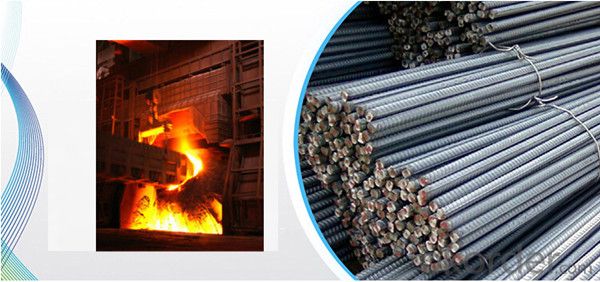
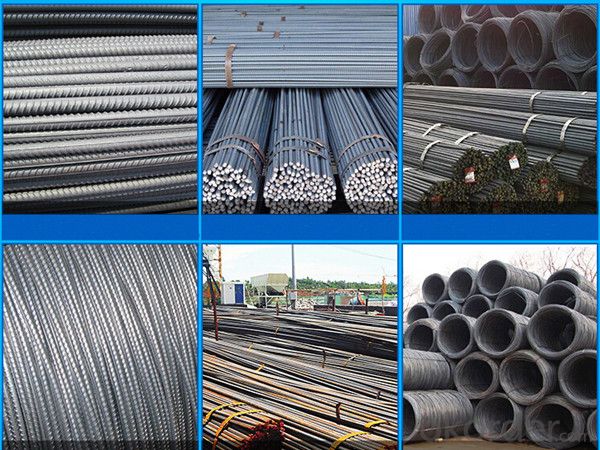
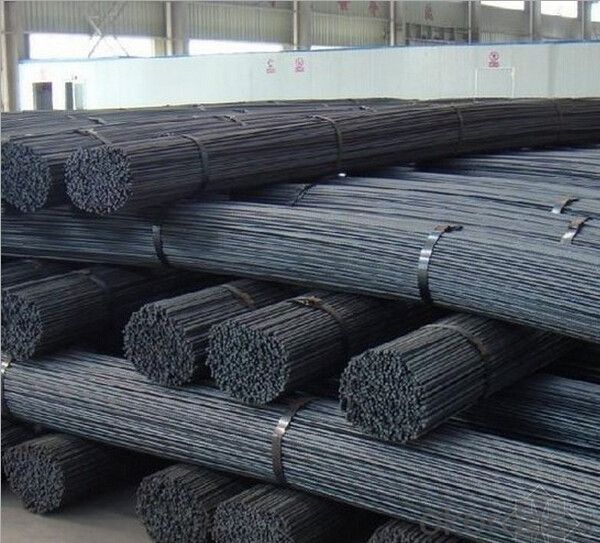
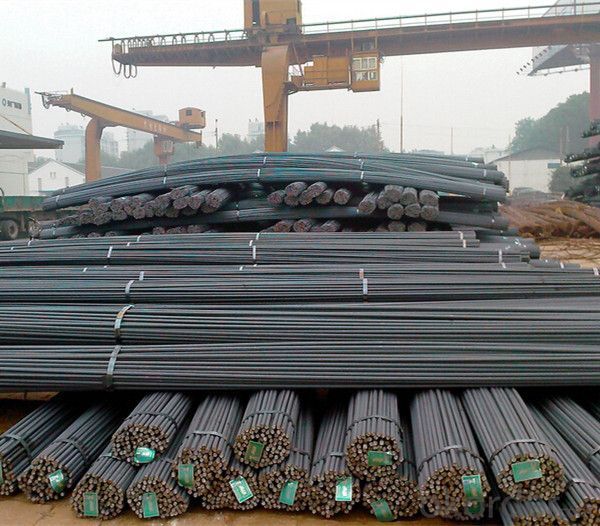
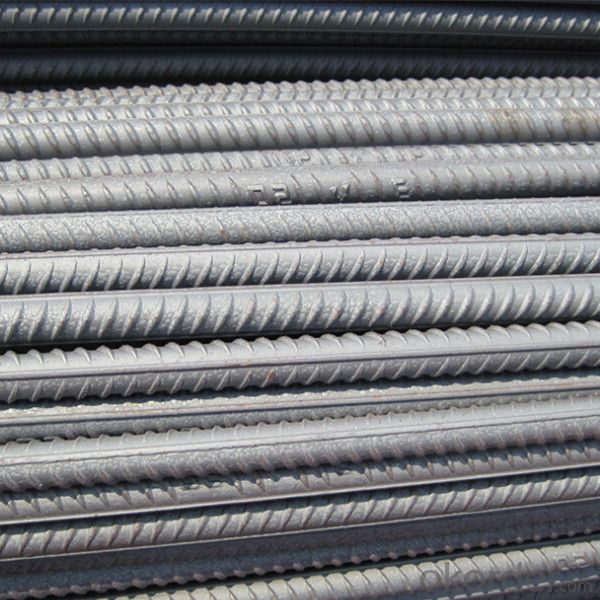
Packages and Shipping:
| Packaging | A seaworthy pachaging or as per customer required |
| Shipping | 10- 30days after we receive 30% deposite |
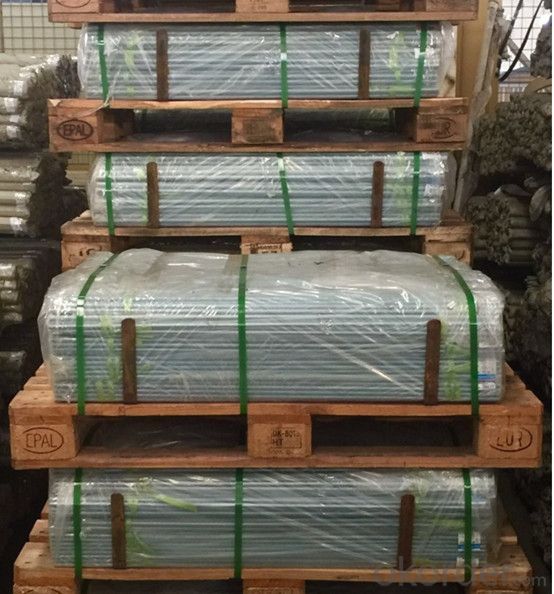
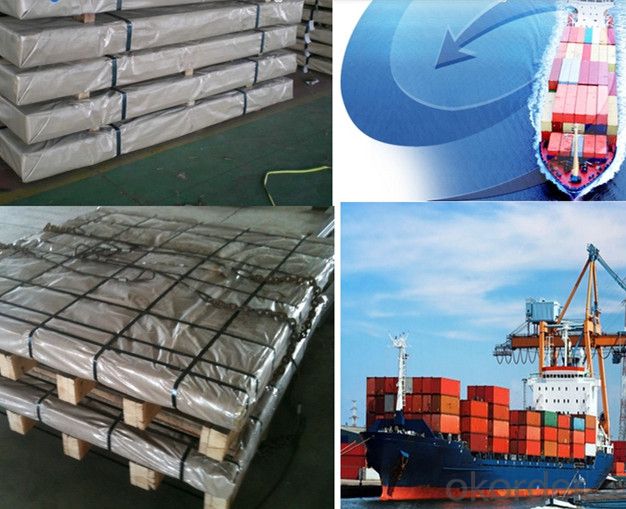
FAQ:
1. Your advantages?
Professional products inquiry, products knowledge train (for agents), smooth goods delivery, excellent customer solution proposale
2. Test & Certificate?
SGS test is available, customer inspection before shipping is welcome, third party inspection is no problem
3. Payment Terms?
30% TT as deposit and 70% before delivery. Or Irrevocable L/C at sight.
4. Trading Terms?
EXW, FOB, CIF, FFR, CNF
5. After-sale Service
We provide the services and support you need for every step of our cooperation. We're the business partner you can trust. For any problem, please kindly contact us at any your convenient time.
- Q: Are there any disadvantages of using steel rebars?
- Yes, there are a few disadvantages of using steel rebars. Firstly, steel rebars are susceptible to corrosion when exposed to moisture and certain chemicals, which can weaken the structure over time. Additionally, steel rebars are relatively heavy, making them challenging to transport and handle on construction sites. Lastly, steel rebars can be more expensive compared to alternative materials, which could increase the overall cost of a construction project.
- Q: How are steel rebars protected against lightning strikes?
- Steel rebars are protected against lightning strikes through a process known as "bonding." During the construction of a structure, steel rebars are connected to a lightning protection system to redirect the electrical energy from a lightning strike safely into the ground. This system typically consists of lightning rods or air terminals installed at the highest points of the structure, which attract the lightning strike. The rebars are then interconnected with conductor cables, creating a network that ensures the lightning current is effectively grounded. The conductor cables are attached to the lightning rods and extend down the structure, connecting with the rebars at various points. By bonding the rebars with the lightning protection system, the electrical charge from a lightning strike is efficiently conducted away from the structure and harmlessly discharged into the ground. Furthermore, additional measures such as surge protection devices are often installed to further protect the rebars and the overall structure from potential damage caused by voltage surges resulting from lightning strikes. These surge protection devices help to minimize the risk of electrical surges that could potentially compromise the integrity of the rebars. In summary, steel rebars are protected against lightning strikes by being properly bonded to a lightning protection system. This ensures that the electrical energy from a lightning strike is safely directed away from the structure and grounded, reducing the risk of damage to the rebars and the overall structural integrity.
- Q: Can steel rebars be used in underground construction projects?
- Yes, steel rebars can be used in underground construction projects. Steel rebars are commonly used for reinforcement in concrete structures, including those built underground. They provide strength and durability to the construction, making them suitable for various underground applications such as tunnels, basements, and underground parking structures.
- Q: What is the maximum length of straight steel rebars available in the market?
- The maximum length of straight steel rebars available in the market typically ranges from 40 feet to 60 feet, depending on the supplier and regional availability.
- Q: What are the main properties of steel rebars?
- Steel rebars, also known as reinforcing bars, are essential components in reinforced concrete structures. They possess several key properties that make them ideal for providing strength and durability to these structures. 1. Strength: One of the primary properties of steel rebars is their high tensile strength. They can withstand significant pulling forces and provide the necessary reinforcement to resist cracking and structural failure in concrete. 2. Ductility: Steel rebars exhibit excellent ductility, meaning they can deform without fracturing under stress. This property allows them to absorb energy during seismic events or other extreme loads, enhancing the overall structural performance and resilience of the reinforced concrete. 3. Corrosion resistance: Steel rebars are typically manufactured with a protective layer, such as epoxy or galvanized coating, to prevent corrosion. This property is crucial as exposure to moisture, chloride ions, and other corrosive elements can significantly weaken the rebars and compromise the integrity of the structure. 4. Weldability: Steel rebars can be easily welded together, allowing for efficient and effective construction. This property ensures that rebars can be connected to form a continuous and robust reinforcement network, enhancing the overall strength and stability of the concrete structure. 5. Thermal compatibility: Steel rebars have similar thermal expansion and contraction properties to concrete, minimizing the risk of cracking or structural damage due to temperature changes. This compatibility ensures the long-term durability and stability of reinforced concrete structures. 6. Availability and cost-effectiveness: Steel rebars are widely available and relatively cost-effective compared to other reinforcing materials. This affordability, combined with their excellent mechanical properties, makes them a popular choice for structural reinforcement across various construction projects. In conclusion, the main properties of steel rebars include high tensile strength, ductility, corrosion resistance, weldability, thermal compatibility, and cost-effectiveness. These properties make steel rebars indispensable for providing structural strength and durability to reinforced concrete structures.
- Q: How do steel rebars prevent the concrete from cracking under tension?
- Steel rebars reinforce concrete and increase its structural integrity, preventing cracking under tension. Concrete has low tensile strength and tends to crack when subjected to tensile forces. However, when steel rebars are embedded in the concrete, they absorb and distribute these forces, acting as reinforcement. Typically made of high-strength steel, the rebars have a much higher tensile strength compared to concrete. As a result, when the concrete is under tension, the rebars bear most of the load, preventing cracking. The rebars act as a framework or skeleton within the concrete, resisting the tensile forces and ensuring its structural stability. Furthermore, the bond between the steel rebar and the concrete also plays a role in preventing cracking under tension. The ribbed or deformed surface of the rebars enhances the bond with the surrounding concrete, creating a strong connection. This bond allows the rebars to transfer the tensile forces to the concrete matrix more effectively, reducing the risk of cracking. By reinforcing the concrete, steel rebars help distribute the tensile forces evenly throughout the structure. This prevents localized stress concentrations and minimizes the chances of cracks forming. Additionally, if cracks do occur, the presence of rebars can help control their propagation by acting as barriers that restrict further spread. In conclusion, steel rebars provide reinforcement, increase the strength of concrete, and prevent cracking under tension. They bear the tensile forces, distribute them evenly, and enhance the bond between the rebar and the concrete. This reinforcement ensures the structural integrity of the concrete and helps prevent cracking.
- Q: How do steel rebars resist alkali-silica reaction in concrete?
- The primary reason why steel rebars can withstand the alkali-silica reaction in concrete is because of the passive film that forms on their surface and the alkaline environment of the concrete. When steel rebars are embedded in concrete, they develop a passive film on their surface. This film serves as a protective layer that prevents direct contact between the steel and the aggressive alkali-silica reactive aggregates that are present in the concrete. The formation of this passive film is a result of the high pH of the alkaline environment created by the cement in the concrete, which usually has a pH level of 12-13. This high pH aids in the creation of an oxide layer on the surface of the steel rebar, effectively shielding it from the reactive elements in the aggregates. Moreover, the alkaline environment of the concrete plays a crucial role in maintaining the passivity of the steel rebars. The alkalinity of the concrete enables the passive film to remain stable and intact, providing a continuous barrier against the alkali-silica reaction. As long as the pH of the concrete remains high, the steel rebars will continue to resist the reaction. It is important to note that the thickness and quality of the passive film on the steel rebars are vital in guaranteeing their resistance to the alkali-silica reaction. Any factors that can compromise the integrity of this film, such as carbonation or chloride contamination, can increase the risk of the reaction occurring. In conclusion, the resistance of steel rebars to the alkali-silica reaction in concrete is primarily due to the presence of a passive film on their surface, which is formed by the alkaline environment of the concrete. This film functions as a protective barrier, preventing direct contact between the steel and the reactive aggregates and minimizing the likelihood of the reaction occurring.
- Q: What are the different types of steel rebars used in road construction?
- There are several types of steel rebars used in road construction, each with its own specific characteristics and advantages. Some of the commonly used types include: 1. Mild Steel Rebars: Also known as carbon steel rebars, these are the most commonly used type in road construction. They have a low carbon content and are relatively inexpensive. Mild steel rebars are suitable for general-purpose applications and provide good strength and ductility. 2. High Strength Deformed (HSD) Rebars: These rebars have higher tensile strength compared to mild steel rebars. They are manufactured by subjecting mild steel bars to mechanical treatments, such as hot rolling, quenching, and tempering. HSD rebars are used in areas where higher load-bearing capacity is required, such as bridge construction. 3. Stainless Steel Rebars: These rebars are corrosion-resistant due to their high chromium content. They are especially beneficial in areas with high humidity, coastal regions, or where road construction is exposed to corrosive substances. Stainless steel rebars are more expensive than other types but offer long-term durability. 4. Epoxy-Coated Rebars: These rebars are coated with epoxy to provide protection against corrosion. Epoxy coating acts as a barrier between the steel surface and the environment, preventing the penetration of moisture and corrosive elements. Epoxy-coated rebars are commonly used in concrete pavements to enhance the longevity of the road. 5. Galvanized Rebars: These rebars are coated with a layer of zinc to protect against corrosion. The zinc coating acts as a sacrificial layer, preventing the steel from coming into contact with corrosive elements. Galvanized rebars are commonly used in road construction projects where corrosion resistance is crucial, such as in areas with high levels of moisture or chemical exposure. It is important to select the appropriate type of steel rebars based on the specific requirements of the road construction project. Factors such as load-bearing capacity, environmental conditions, and budget considerations play a significant role in determining the most suitable type of rebar to be used.
- Q: Can steel rebars be used in structures with high aesthetic requirements?
- Yes, steel rebars can be used in structures with high aesthetic requirements. While steel rebars are primarily used for their strength and durability, they can also be designed and incorporated in a way that meets aesthetic requirements. Rebars can be shaped, bent, or painted to match the desired aesthetic of the structure. Additionally, they can be hidden within the structure or covered by other materials to maintain a clean and visually appealing appearance. With careful planning and design, steel rebars can be successfully used in structures with high aesthetic requirements without compromising their functionality or visual appeal.
- Q: What are the specifications of thread steel?
- Thread steel small specifications of 101214, in the specifications of 1618202225, large specifications of 2832, size, specifications, in general, in accordance with the specifications on the basis of 20-100 yuan, if the larger 364042.It is a smaller disk 6.5810, because too small easy to bend, so the coiled coil shape, called disk.
Send your message to us
Deformed Steel Bar Astm A615 Grade 40 Grade 60 Rebar Steel Prices
- Loading Port:
- Tianjin
- Payment Terms:
- TT OR LC
- Min Order Qty:
- 100 m.t.
- Supply Capability:
- 100000 m.t./month
OKorder Service Pledge
OKorder Financial Service
Similar products
Hot products
Hot Searches
Related keywords
